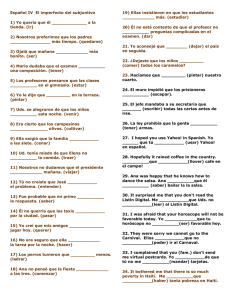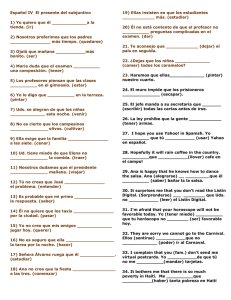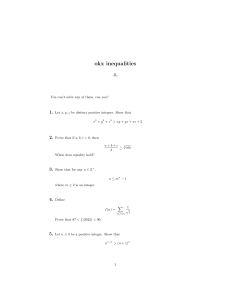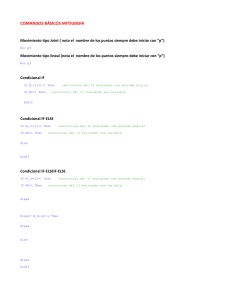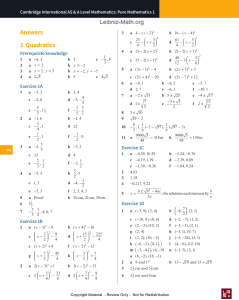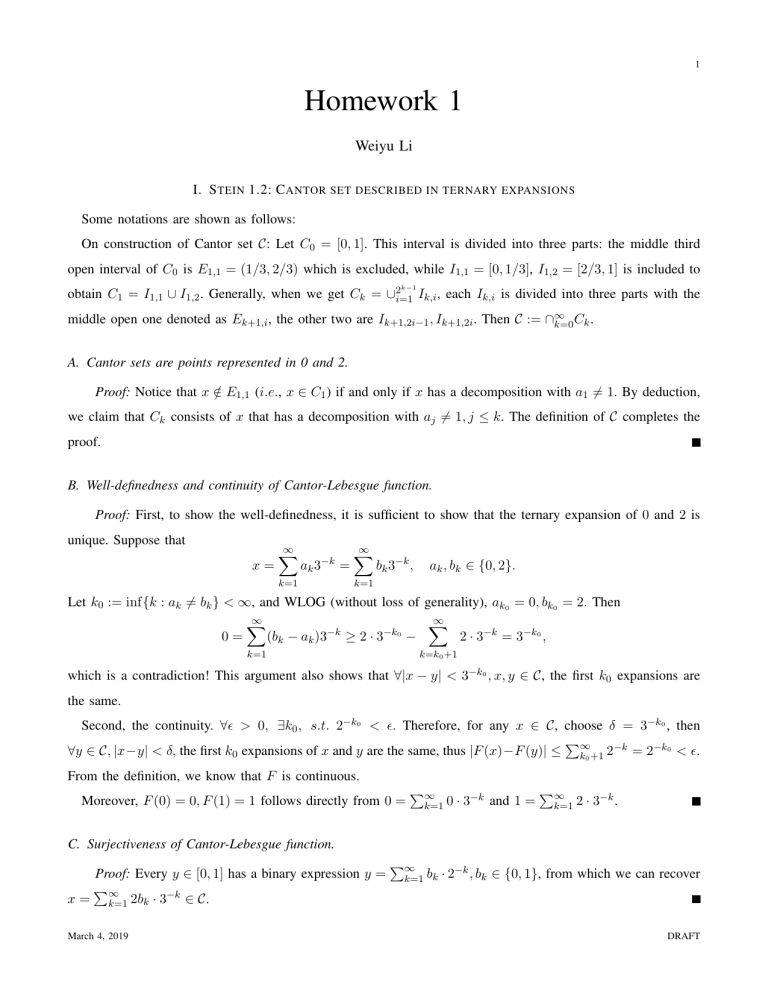
1
Homework 1
Weiyu Li
I. S TEIN 1.2: C ANTOR SET DESCRIBED IN TERNARY EXPANSIONS
Some notations are shown as follows:
On construction of Cantor set C : Let C0 = [0, 1]. This interval is divided into three parts: the middle third
open interval of C0 is E1,1 = (1/3, 2/3) which is excluded, while I1,1 = [0, 1/3], I1,2 = [2/3, 1] is included to
k−1
obtain C1 = I1,1 ∪ I1,2 . Generally, when we get Ck = ∪2i=1 Ik,i , each Ik,i is divided into three parts with the
middle open one denoted as Ek+1,i , the other two are Ik+1,2i−1 , Ik+1,2i . Then C := ∩∞
k=0 Ck .
A. Cantor sets are points represented in 0 and 2.
Proof: Notice that x ∈
/ E1,1 (i.e., x ∈ C1 ) if and only if x has a decomposition with a1 6= 1. By deduction,
we claim that Ck consists of x that has a decomposition with aj 6= 1, j ≤ k . The definition of C completes the
proof.
B. Well-definedness and continuity of Cantor-Lebesgue function.
Proof: First, to show the well-definedness, it is sufficient to show that the ternary expansion of 0 and 2 is
unique. Suppose that
x=
∞
X
ak 3−k =
k=1
∞
X
bk 3−k ,
ak , bk ∈ {0, 2}.
k=1
Let k0 := inf{k : ak 6= bk } < ∞, and WLOG (without loss of generality), ak0 = 0, bk0 = 2. Then
0=
∞
∞
X
X
2 · 3−k = 3−k0 ,
(bk − ak )3−k ≥ 2 · 3−k0 −
k=1
k=k0 +1
which is a contradiction! This argument also shows that ∀|x − y| < 3−k0 , x, y ∈ C , the first k0 expansions are
the same.
Second, the continuity. ∀ > 0, ∃k0 , s.t. 2−k0 < . Therefore, for any x ∈ C , choose δ = 3−k0 , then
P
−k = 2−k0 < .
∀y ∈ C, |x−y| < δ, the first k0 expansions of x and y are the same, thus |F (x)−F (y)| ≤ ∞
k0 +1 2
From the definition, we know that F is continuous.
Moreover, F (0) = 0, F (1) = 1 follows directly from 0 =
P∞
k=1 0
· 3−k and 1 =
P∞
k=1 2
· 3−k .
C. Surjectiveness of Cantor-Lebesgue function.
Proof: Every y ∈ [0, 1] has a binary expression y =
P∞
x = k=1 2bk · 3−k ∈ C .
March 4, 2019
P∞
k=1 bk
· 2−k , bk ∈ {0, 1}, from which we can recover
DRAFT
2
D. Continuity of extended Cantor-Lebesgue function.
Proof: Note that F |C is non-decreasing and the extended definition can be interpreted as F (x) := F (sup{y :
y ∈ C, y ≤ x} = sup{F (y) : y ∈ C, y ≤ x} for any x ∈ [0, 1], or F (x) := inf{F (y) : y ∈ C, y ≥ x} due to the
monotonicity of F |C and closedness of C .
∀ > 0, x ∈ [0, 1], choose δ = 3−k0 same as in (I-B), (s.t. 2−k0 < ,) then ∀|x − y| < δ, if x, y ∈ C,
P
−k = 2−k0 < ; else, WLOG y > x, let x0 = inf{z : z ∈ C, z ≥ x} and y 0 = inf{z :
|F (x) − F (y)| ≤ ∞
k0 +1 2
z ∈ C, z ≤ y}, then |F (x) − F (y)| = |F (x0 ) − F (y 0 )| < . From the definition, F is continuous.
II. S TEIN 1.3: C ANTOR SETS Cξ
A. Interpretation of Cξc .
Proof: Same notations as in the construction of C . In the space of C0 , |C1 | = 1 − ξ , and by deduction
c
∞
c
|Ck | = (1 − ξ)k . Also note that Ckc is unions of finite open intervals. Therefore, Cξc = (∩∞
k=0 Ck ) = ∪k=0 Ck is
the union of open intervals with total length no less than 1 − |Ck | → 1. Constrained in [0, 1], the total length
equals to 1.
B. m∗ (Cξ ) = 0.
Proof: From the definition,
0 ≤ m∗ (Cξ ) = inf{
∞
X
|Qj | Cξ ⊂ ∪∞
j=1 Qj , Qj are closed intervals} ≤ inf |Ck | = 0.
j=1
Thus, m∗ (Cξ ) = 0.
III. S TEIN 1.14: O UTER J ORDAN CONTENT -
FINITE COVERING INTERVALS
A. J∗ (E) = J∗ (Ē).
P
N
N
N ¯
Proof: If Ē ⊂ ∪N
j=1 Ij , then E ⊂ Ē ⊂ ∪j=1 Ij , thus J∗ (E) ≤ J∗ (Ē). If E ⊂ ∪j=1 Ij , then Ē ⊂ ∪j=1 Ij with
P ¯
|Ij | =
|Ij |, thus J∗ (E) ≥ J∗ (Ē).
B. J∗ (E) = 1, m∗ (E) = 0.
E = Q ∩ [0, 1] is an example.
March 4, 2019
DRAFT
3
IV. S TEIN 1.15: O UTER MEASURE mR
∗
BY COUNTABLE COVERING RECTANGLES
Proof: Given E , since cubes are rectangles, m∗ (E) ≥ mR
∗ (E).
R
To prove m∗ (E) ≤ mR
∗ (E), WLOG, m := m∗ (E) < ∞. For any > 0, there exists a countable covering
P
E ⊂ ∪Rj , such that m ≤ ∞
j=1 |Rj | < m + . For each Rj = [a1j , b1j ] × . . . × [adj , bdj ], consider the grid
method in proof of Theorem 1.4, but with side length small enough and accept all the tentatively accepted
cubes. The almost disjoint accepted cubes {Qji , i = 1, . . . , nj } make up of a rectangle Qj ⊃ Rj and from
Pnj
Lemma 1.1 satisfy |Qj | = i=1
|Qji | ≤ |Rj | + /2j . In summary, we have ∪j≥1,1≤i≤nj Qji ⊃ ∪Rj ⊃ E with
P
P
j
ij |Qji | ≤
j (|Rj | + /2 ) ≤ m + 2. Since is arbitrary chosen, m∗ (E) ≤ m.
Remark 1. Lemma 1.1 is the finite sum. If you want to use the infinity summation, please use Observation 5 in
P15 instead.
March 4, 2019
DRAFT
